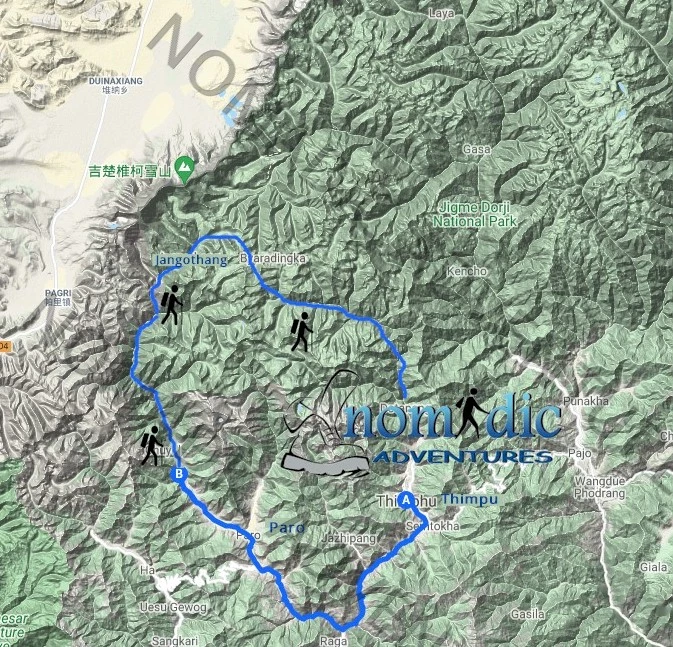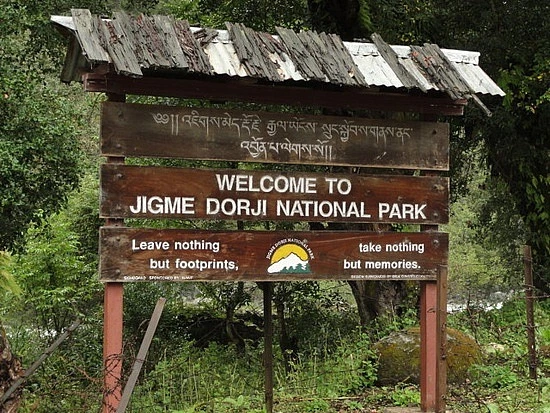Day-1: Arrive Paro - Thimphu
 Upon arrival meet with our representative and after lunch transfer to Hotel. Overnight at Hotel in Paro.
Upon arrival meet with our representative and after lunch transfer to Hotel. Overnight at Hotel in Paro.
Day-2: Paro Sightseeing
Visit Kychu Lhakahang, National Museum and Paro Dzong. Later in the evening assemble the trekking gear. Overnight at Hotel in Paro.
Day-3: Paro - Shana
Drive up to Drukgyel Dzong where the road ends and trek begins, follow the river gently uphill through a agricultural valley and the village. Overnight stop at height of 2,800 m. Dist. 17 km. 5 to 6 hours.
Day-4: Shana - Thangthayka
Continue uphill through the alpine forest. It narrows and closes in and the winds along the drainage. The trek is mostly through the deep forest. Camp is in a meadow with a stone shelter. Alt. 3750m. Dist. 20 km. 8 to 9 hours.

Day-5: Soi Thangthayka - Jangothang
Continue up the Pa Chhu (river). Pass a small army post where the valley begins to widen again. Now views of high ridges and snow-capped peaks can be seen all around. Camp beneath a ruined fortress at the base of Mt. Jhomolhari and Mt. Jichu Drake. Alt: 4,040 m, Dist: 19 km, time about 6 1/2 hrs.
Day-6: Jangothang
Trek up to Tsophu for fishing or do any one of the three hiking excursions. Mt. Jhomolhari and its subsidiary are due west, Mt. Jichu Drake is to the north, unclimbed summits and ridges are to the east.
Day-7: Jangothang - Lingshi
Wide yak pastures are visible both on ways up and down the pass. You may encounter some nomads in their yak tents. You can see the Lingshi Dzong. Tserim Kang and its descending glaciers are at the north end of the valley from the Nyuele la pass alt. 4700m. Camp at alt: 4150 m, dist: 19 km. 7 to 8 hours.

Day-8: Lingshi
On this day, at Lingshi for one-day excursion to Tsokha, the base camp of Jichu Drake. Large herds of blue sheep and musk deer may be seen. Alt: 4,500 m, dist 15 km.
Day-9: Lingshi - Shodu
The trail ascends up to the Yalila Pass, altitude 4820 m, from the pass, Mt. Jhomolhari, Tserim Gang and Mt. Masagang can be seen on clear days. Then descend. Camp at ht: 3,963 m, 22 km. 9 to 10 hours.
Day-10 : Shodu - Barshong
Follow Wang Chhu through the forest of rhododendron and waterfalls, the river then narrows and closed in and the trail winds ascending to the ruins of Barshong Dzong. Camp just below the Dzong. Atl: 3,785 m dist: 13 kms. 6 to 7 hours.
Day-11: Barshong - Dolam -Kencho
Descend gradually to meet Wang Chhu, passing through forests of Rhododendron, then ascend once again onto pasture land. Camp in meadow. Atl: 3,628 m, dist: 11 km. 5 to 6 hours.
Day-12: Dolam Kencho - Thimphu.
Continue uphill through the forest to a small pass. The trial winds up and along the drainage. Wild animals may be seen. At Dodina, meet the transportation for drive to Thimphu. Dist: 14 km. 6 to 7 hours. Overnight at Hotel in Thimphu.

Day-13: Thimphu - Punakha
Morning Thimphu sightseeing, visit Memorial Chorten, Painting School, National Library. After lunch drive to Punakha/Wangdi across the Dochula Pass ( Alt: 3050m ) where once can see the beautiful views across the Dochula Pass (Alt: 3050 m) of Eastern Himalayan Range. Overnight at Hotel in Wangdi.
Day-14: Punakha - Paro
Visit Wangdi Dzong and Punakha Dzong, which is the winter home of Central Monk body (Je-Khenpo). After lunch transfer to Paro. Overnight Hotel
Day-15: Final Departure.
Drive to airport for the final departure.
End of services
